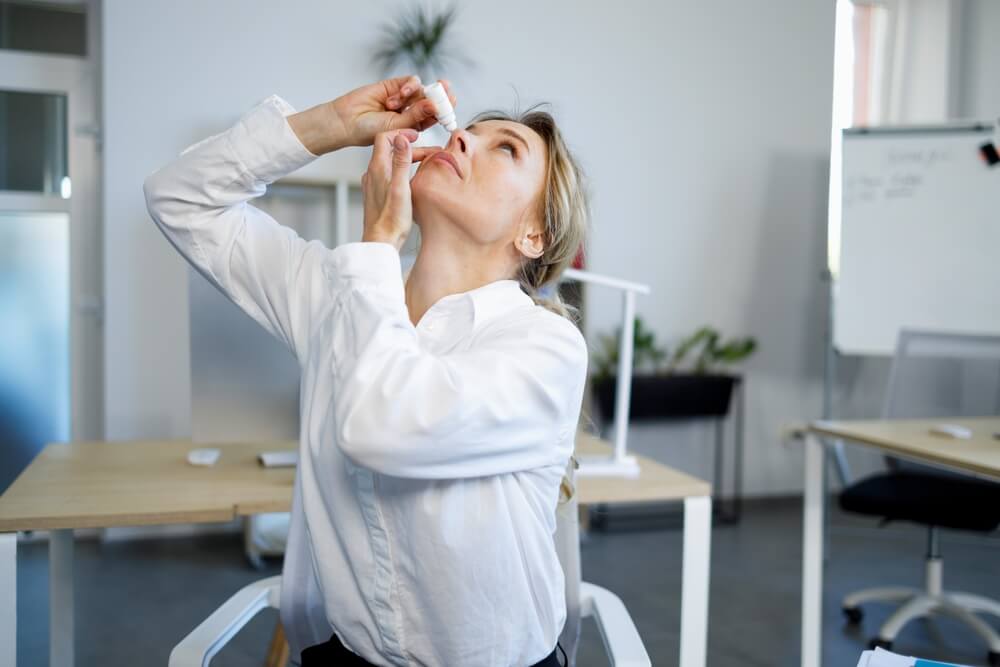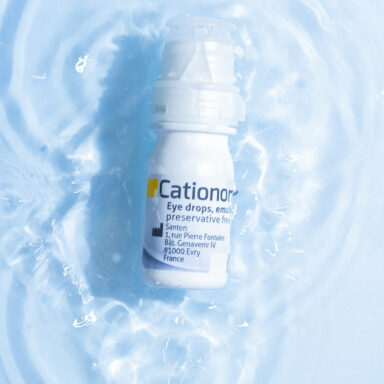If your eyes feel dry, irritated or tired after a long day of scrolling through Instagram, typing emails or watching Netflix, you may be asking yourself, can screen time cause dry eyes?
The short answer is yes. Staring at screens for too long can cause eyestrain, blurred vision, headaches and dry eye, leading to a condition known as Computer Vision Syndrome (CVS) or digital eyestrain.1 People who spend two or more continuous hours at a computer or use a digital screen device every day are at risk – so, that’s most of us!2
Did you know?
According to the Vision Council, 80% of adults use digital devices for at least 2 hours daily.3
Post pandemic, the problem has only gotten worse, with many of us now spending even more time in front of screens due to remote working, learning, and socialising. A survey of 500 UK adults revealed that half of respondents now look at screens for 11 hours or more a day, with more than a quarter looking at screens for 14 hours or more.4 Ouch!
It’s not just our comfort that’s affected either. A survey of 505 modern office workers shows that dry eye – one of the most common features of digital eye strain and CVS – can lead to around 30% decrease in workplace performance, productivity and non-job-related activities.5

OK, so no one is about to ditch the devices to avoid dry eye – It’s just not practical and screens add so many benefits to our lives like, ahem, reading this article. Luckily, there’s no need to sacrifice your eyes for the sake of screens; keep scrolling to find out more.
Causes of dry eyes from screen time
While we may love our screens, our eyes don’t feel the same way. When you stare at a screen, three things happen to your delicate tear film – the watery protective layer:
1. You blink less
Normally, we blink around every 10 seconds and this releases and distributes tears over the eye to moisture and protect them.6 But, when we use screens, we blink two to three times less than usual.7
2. The balance of your tears change
A study in Japan found that people who spent hours on their computers had lower levels of mucus in their tears. Nearly 1 in 10 workers in the study had dry eye, and more than half had probable cases.6
Did you know?
Our tears – also known as the tear film – is made up of three layers: the oily layer on the outside, the watery layer in the middle, and the inner, mucus layer. It’s a delicate balance to keep our eyes feeling at their best.6
3. Your blinks get worse
Blinking fully is important to spread your tears over the eye. A small study found a positive correlation between CVS symptoms and the percentage of incomplete blinks during a task, highlighting this as an equally important factor in causing dry eye from screen time.8

So how much screen time is bad for eyes? Research show that the longer you use your screens, the more you’re at risk.4 A study by Leeds University found that 93% of negative health impacts occurred in those looking at screens for six or more hours each day, and those using screens for more than nine hours a day were significantly more likely to experience negative health impacts.4
However, a separate small study of video game playing on a computer screen, found changes in the tear film after just 20 minutes and Leeds University notes that no amount of screen time can be considered risk free!9
As well as the amount of time you spend using screens, there are some other causes of dry eye and factors that can put you at higher risk including:10
- Aged over 50 years
- Other eye conditions, such as glaucoma
- Contact lens wearing
- Allergies such as hay fever
- Certain autoimmune conditions
- Pregnancy and the menopause
What are the symptoms of dry eye from screen time?
Computer Vision Syndrome – also known as digital strain and digital eye fatigue – happens in some people when they use computer, tablet, smartphone, TV or video gaming screens over a long period. The most common symptoms include:11
- Eye fatigue
- Headache
- Blurred vision / double vision
- Head and neck pain
- Dry eye
You may have dry eyes if your eyes are:10
How to prevent dry eyes from screen time
In today’s digital world, it’s almost impossible to avoid many daily hours of screen time, particularly if you have an office job. However, the working environment can make strain worse. For example, in a survey of 505 modern office workers where 70% reported being inhibited by eye symptoms, the majority worked in an environment with an air draft (79%) and had no adjustable light (82%).5 Sound familiar?

Here’s some tips for creating an eye friendly workspace:7
- Lighting
Make sure it is well-lit, preferably with natural light and a window.
- Screen position
Your computer screen should be just below eye level and directly in front of you.
- Avoid screen-reflection
Position your monitor to avoid reflection from overhead lighting and sunlight.
- Adjust your screen settings
Enlarge the type for easier reading and adjust the contrast and brightness for comfort.
- Follow the 20/20/20 rule
Take a 20-second break from your digital device every 20 minutes and look at something 20 feet away.
- Try a humidifier
It adds moisture to dry indoor air, so your eyes won’t dry out as quickly.
- Air conditioning positioning
Try not to sit near air conditioning vents which could blow air into your eyes.
- Dual screening
Simultaneous use of 2 or more devices increased the risk of CVS compared to the use of 1 device at a time and the reported prevalence was 75% and 53% respectively.12
Did you know?
Some research has found that reading from smartphones may be less drying to your eyes than from computers. It’s thought that a lower gaze, looking down onto a smartphone, exposes less of the eyes surface.9
How can dry eyes from screen time be treated?
Dry eyes resulting from digital strain can be mild, but in severe cases, it can cause permanent damage to the eye’s surface. That’s why it’s crucial to address the symptoms.
While lifestyle changes can be helpful, they may not always be enough to manage dry eyes effectively. In these cases, a type of eye drop called artificial tears can help.

These work by mimicking the natural tears that are produced by the eyes, helping to keep the eyes moist and comfortable. Using artificial tears can also help to reduce eye fatigue and improve visual acuity, making it easier to work or engage with digital devices for longer periods of time.
Top tip
Some eye drops contain preservatives that can irritate the eyes, but preservative-free options are available from your local pharmacist or online.
If lifestyle changes and treatment are still not improving your symptoms, it’s essential to speak to your healthcare professional.
Did you know?
Blue light glasses have filtering materials or coatings on the lenses that block a portion of blue light emitted by digital screens and lighting. A 2017 review found insufficient evidence to support the potential benefits of blue light glasses, and some retailers have been fined for making misleading claims.2




